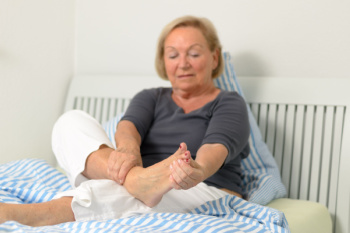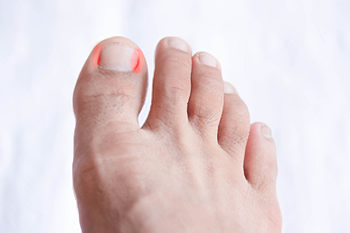Connect With Us
Blog

Spending long hours standing in the classroom can take a toll on a teacher’s feet, legs, and lower back. Over time, the strain from hard floors and constant movement may lead to fatigue, soreness, or even more serious issues like plantar fasciitis or joint pain. Choosing supportive shoes with proper cushioning and arch support is a good place to start, but there are other helpful habits. Alternating between sitting and standing when possible, using a cushioned mat at a standing desk or podium, and stretching throughout the day can all ease pressure and improve circulation. Paying attention to posture and weight distribution also helps reduce tension. Even minor adjustments in daily routine can lead to noticeable relief and long-term comfort. If pain persists or becomes more intense, it is suggested that you see a podiatrist for additional tips on how to relieve foot pain.
While working on the feet, it is important to take the proper care of them. For more information about working on your feet, contact one of our podiatrists from Lakeside Foot and Ankle Center. Our practitioners will treat your foot and ankle needs.
Working on Your Feet
Standing on your feet for long periods of time can cause stress and pain in your feet. Your whole body may experience change in terms of posture, back pain, bunions, callouses and or plantar warts. There are ways to avoid these conditions with proper foot care, smart choices and correct posture.
Positive Changes
Negative heeled shoe – Choosing this shoe type places the heel slightly lower than the ball of the foot. These are great for overall foot health. Find shoes that fit you correctly.
Go barefoot – Our feet were not designed to be enclosed for all hours of the day. Try to periodically expose your feet to air.
Eliminate Pain
Foot Exercises – Performing simple exercises, incorporating yoga and doing stretches are beneficial. This will allow increased blood flow to the area and muscles of the foot.
Achilles tendon – Stretching the foot out flat on the floor will relax the calf muscles and tendon. These exercises can be performed almost anywhere. Make sure you add these exercises to your daily regimen.
With a little bit of this information and knowing more about foot health, you will notice changes. Foot stretches and proper footwear will help with pain and prevent further issues.
If you have any questions please feel free to contact our offices located in Leesburg and The Villages, FL . We offer the newest diagnostic and treatment technologies for all your foot and ankle needs.

Gout is a form of arthritis that develops when uric acid crystals accumulate in the joints, commonly in the big toe, causing pain, swelling, and inflammation. Although it is more common in men, women, particularly after menopause, are also at risk due to hormonal changes that affect uric acid levels. Other risk factors include a diet high in red meat, seafood, and sugary beverages, as well as conditions such as obesity, hypertension, and kidney disease. Managing gout involves maintaining a healthy diet, staying hydrated, and avoiding alcohol and purine-rich foods. Medication that lowers uric acid levels may also help prevent flare-ups. Regular exercise and weight management can reduce pressure on the joints. Gout can cause severe pain, and it may be difficult to complete daily activities. If you have symptoms of gout, it is suggested that you consult a podiatrist who can help you manage this condition.
Gout is a painful condition that can be treated. If you are seeking treatment, contact one of our podiatrists from Lakeside Foot and Ankle Center. Our practitioners will treat your foot and ankle needs.
What Is Gout?
Gout is a form of arthritis that is characterized by sudden, severe attacks of pain, redness, and tenderness in the joints. The condition usually affects the joint at the base of the big toe. A gout attack can occur at any random time, such as the middle of the night while you are asleep.
Symptoms
- Intense Joint Pain - Usually around the large joint of your big toe, and it most severe within the first four to twelve hours
- Lingering Discomfort - Joint discomfort may last from a few days to a few weeks
- Inflammation and Redness -Affected joints may become swollen, tender, warm and red
- Limited Range of Motion - May experience a decrease in joint mobility
Risk Factors
- Genetics - If family members have gout, you’re more likely to have it
- Medications - Diuretic medications can raise uric acid levels
- Gender/Age - Gout is more common in men until the age of 60. It is believed that estrogen protects women until that point
- Diet - Eating red meat and shellfish increases your risk
- Alcohol - Having more than two alcoholic drinks per day increases your risk
- Obesity - Obese people are at a higher risk for gout
Prior to visiting your podiatrist to receive treatment for gout, there are a few things you should do beforehand. If you have gout you should write down your symptoms--including when they started and how often you experience them, important medical information you may have, and any questions you may have. Writing down these three things will help your podiatrist in assessing your specific situation so that he or she may provide the best route of treatment for you.
If you have any questions, please feel free to contact our offices located in Leesburg and The Villages, FL . We offer the newest diagnostic and treatment technologies for all your foot care needs.

Ingrown toenails occur when the edges of a toenail grow into the surrounding skin, causing pain, swelling, and redness. This condition most commonly affects the big toe and can result from improper nail trimming, wearing tight shoes, or trauma to the toe. In some cases, ingrown toenails can develop due to fungal infections or genetic factors. Symptoms include sharp pain, tenderness, and swelling surrounding the affected toenail. In more severe cases, an infection may develop, leading to pus or discharge from the area. The toe may appear red or inflamed, making wearing shoes or walking uncomfortable. A podiatrist can diagnose and treat ingrown toenails through various methods, such as recommending proper nail care, prescribing antibiotics for infections, or performing minor surgery to remove the ingrown portion of the nail. If you have a painful ingrown toenail, it is suggested that you schedule an appointment with a podiatrist, who can provide appropriate treatment solutions.
Ingrown toenails may initially present themselves as a minor discomfort, but they may progress into an infection in the skin without proper treatment. For more information about ingrown toenails, contact one of our podiatrists of Lakeside Foot and Ankle Center. Our practitioners can provide the care you need to keep you pain-free and on your feet.
Ingrown Toenails
Ingrown toenails are caused when the corner or side of a toenail grows into the soft flesh surrounding it. They often result in redness, swelling, pain, and in some cases, infection. This condition typically affects the big toe and may recur if it is not treated properly.
Causes
- Improper toenail trimming
- Genetics
- Improper shoe fitting
- Injury from pedicures or nail picking
- Abnormal gait
- Poor hygiene
You are more likely to develop an ingrown toenail if you are obese, have diabetes, arthritis, or have any fungal infection in your nails. Additionally, people who have foot or toe deformities are at a higher risk of developing an ingrown toenail.
Symptoms
Some symptoms of ingrown toenails are redness, swelling, and pain. In rare cases, there may be a yellowish drainage coming from the nail.
Treatment
Ignoring an ingrown toenail can have serious complications. Infections of the nail border can progress to a deeper soft-tissue infection, which can then turn into a bone infection. You should always speak with your podiatrist if you suspect you have an ingrown toenail, especially if you have diabetes or poor circulation.
If you have any questions, please feel free to contact our offices located in Leesburg and The Villages, FL . We offer the newest diagnostic and treatment technologies for all your foot care needs.
Blog Archives
- April 2025
- March 2025
- February 2025
- January 2025
- December 2024
- November 2024
- October 2024
- September 2024
- August 2024
- July 2024
- June 2024
- May 2024
- April 2024
- March 2024
- February 2024
- January 2024
- December 2023
- November 2023
- October 2023
- September 2023
- August 2023
- July 2023
- June 2023
- May 2023
- April 2023
- March 2023
- February 2023
- January 2023
- December 2022
- November 2022
- October 2022
- September 2022

